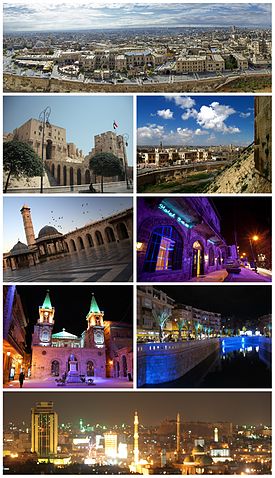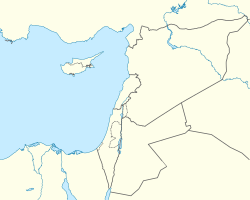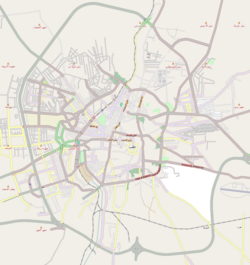
Back Halab ACE Aleppo Afrikaans ሐለብ Amharic حلب Arabic ܚܠܒ (ܡܕܝܢܬܐ) ARC حلب ARZ Alepu AST ХӀалаб AV Hələb Azerbaijani حلب AZB
Aleppo
ﺣَﻠَﺐ | |
|---|---|
 Ancient City of Aleppo Aleppo Citadel • The entrance to al-Madina Souq Great Mosque of Aleppo • Baron Hotel Saint Elijah Cathedral • Queiq River Panorama of Aleppo at night | |
| Nickname(s): | |
| Coordinates: 36°12′N 37°10′E / 36.20°N 37.16°E | |
| Country | |
| Governorate | Aleppo |
| District | Mount Simeon (Jabal Semaan) |
| Subdistrict | Mount Simeon (Jabal Semaan) |
| Control | Syrian transitional government Syrian Democratic Forces[a] |
| First settled | c. 5000 BC |
| First city council | 1868 |
| Government | |
| • Type | Mayor–council government |
| • Governor | Azzam al-Gharib |
| • Mayor | Vacant |
| Area | |
• Total | 190 km2 (70 sq mi) |
| Elevation | 379 m (1,243 ft) |
| Population (2021 est.) | |
• Total | 2,098,210 |
| • Rank | 2nd in Syria 18th in the Arab World |
| • Density | 11,000/km2 (29,000/sq mi) |
| Demonym(s) | Arabic: حلبي Ḥalabi English: Aleppine[2] |
| Time zone | UTC+3 |
| Area code(s) | Country code: 963 City code: 21 |
| Geocode | C1007 |
| Climate | BSk |
| International airport | Aleppo International Airport |
 | |
| Sources: Aleppo city area[3] Sources: City population[4][5][6][7] | |
| Official name | Ancient City of Aleppo |
| Type | Cultural |
| Criteria | iii, iv |
| Designated | 1986 (10th session) |
| Reference no. | 21 |
| Region | Arab States |
Aleppo (/əˈlɛpoʊ/ ə-LEP-oh; Arabic: ﺣَﻠَﺐ, ALA-LC: Ḥalab, IPA: [ˈħalab]) is a city in Syria, which serves as the capital of the Aleppo Governorate, the most populous governorate of Syria.[8] With an estimated population of 2,098,000 residents as of 2021,[update][9] it was Syria's largest city until its population was surpassed by Damascus, the capital of Syria, and is the largest city in Syria's northern governorates and also one of the largest cities in the Levant region.[10][11]
Aleppo is one of the oldest continuously inhabited cities in the world; it may have been inhabited since the sixth millennium BC.[12][13][14][15][16] Excavations at Tell as-Sawda and Tell al-Ansari, just south of the old city of Aleppo, show that the area was occupied by Amorites by the latter part of the third millennium BC.[17] That is also the time at which Aleppo is first mentioned in cuneiform tablets unearthed in Ebla and Mesopotamia, which speak of it as part of the Amorite state of Yamhad, and note its commercial and military importance.[18] Such a long history is attributed to its strategic location as a trading center between the Mediterranean Sea and Mesopotamia. For centuries, Aleppo was the largest city in the Syrian region, and the Ottoman Empire's third-largest after Constantinople (now Istanbul) and Cairo.[19][20][21] The city's significance in history has been its location at one end of the Silk Road, which passed through Central Asia and Mesopotamia. When the Suez Canal was inaugurated in 1869, much trade was diverted to sea and Aleppo began its slow decline.
At the fall of the Ottoman Empire after World War I, Aleppo lost its northern hinterland to modern Turkey, as well as the important Baghdad Railway connecting it to Mosul. In 1939, it lost its main access to the sea, by Antakya and İskenderun, also to Turkey. The growth in importance of Damascus in the past few decades further exacerbated the situation. This decline may have helped to preserve the old city of Aleppo, its medieval architecture and traditional heritage. It won the title of the Islamic Capital of Culture 2006 and has had a wave of successful restorations of its historic landmarks. The battle of Aleppo occurred in the city during the Syrian civil war, and many parts of the city suffered massive destruction.[22][23] Affected parts of the city are currently undergoing reconstruction.[24][25] An estimated 31,000 people were killed in Aleppo during the conflict.[26]
- ^ Almaany Team. "معنى كلمة شَهْباءُ في معجم المعاني الجامع والمعجم الوسيط – معجم عربي عربي – صفحة 1". almaany.com. Archived from the original on 22 June 2014. Retrieved 22 June 2014.
- ^ "Aleppine". Lexico. Oxford University Press. Archived from the original on 13 February 2017. Retrieved 12 February 2017.
- ^ Cite error: The named reference
Syr-news1was invoked but never defined (see the help page). - ^ Central Bureau of Statistics (CBS). Aleppo Subdistrict Population Archived 20 May 2012 at the Wayback Machine.
- ^ "'Ferocious' air strikes pummel Aleppo as ground gained". Al Jazeera. 24 September 2016. Archived from the original on 6 October 2016. Retrieved 4 October 2016.
- ^ "Syrian Arab Republic: Aleppo Situation Report No. 14 (20 January 2017) – Highlights of the Report of the UN Office for the Coordination of Humanitarian Affairs". 21 January 2017. Archived from the original on 5 February 2017. Retrieved 4 February 2017.
- ^ "Aleppo population 2021". worldpopulationreview.com. Archived from the original on 12 June 2022. Retrieved 24 April 2022.
- ^ "Syrian Arab republic". UN Data. 24 October 1945. Archived from the original on 7 March 2012. Retrieved 11 March 2012.
- ^ "Population of Aleppo from 1950-2022". Macrotrends. Archived from the original on 21 August 2022. Retrieved 21 August 2022.
- ^ Aleppo city population Archived 2012-05-20 at the Wayback Machine
- ^ "بـ 4.6 ملايين نسمة .. محافظة حلب الأعلى سكانياً في سورية | عكس السير دوت كوم". Archived from the original on 17 September 2017. Retrieved 28 June 2017.
- ^ Versaci, Antonella; Bougdah, Hocine; Akagawa, Natsuko; Cavalagli, Nicola (1 March 2022). Conservation of Architectural Heritage. Springer Nature. ISBN 978-3-030-74482-3.
- ^ Research, United Nations Institute for Training and (30 May 2019). Five years of conflict: the state of cultural heritage in the Ancient City of Aleppo; A comprehensive multi-temporal satellite imagery-based damage analysis for the Ancient City of Aleppo. UNESCO Publishing. ISBN 978-92-3-100284-7.
- ^ Murakami, Nancy J.; Akilova, Mashura (25 November 2022). Integrative Social Work Practice with Refugees, Asylum Seekers, and Other Forcibly Displaced Persons. Springer Nature. ISBN 978-3-031-12600-0.
- ^ Alafandi, Rami (1 January 2013). "ARCHITECTURAL HERITAGE OF ALEPPO: PAST, PRESENT AND FUTURE". International Conference on Universal Design in the Built Environment.
- ^ Ibrahim, S. (24 July 2020). "Decision-Making Methodology Between Revitalisation and Rehabilitation of World Heritage City Centers. Case Study: The Ancient City of Aleppo (Syria)". The International Archives of the Photogrammetry, Remote Sensing and Spatial Information Sciences. XLIV-M-1-2020: 255–262. Bibcode:2020ISPAr44M1..255I. doi:10.5194/isprs-archives-XLIV-M-1-2020-255-2020. ISSN 2194-9034. S2CID 221663582.
- ^ The Oxford Encyclopedia of Archaeology in the Near East (1997)
- ^ Britannica Concise Encyclopedia (2010)[full citation needed]
- ^ Gábor Ágoston; Bruce Alan Masters (2010). Encyclopedia of the Ottoman Empire. Infobase Publishing. p. 30. ISBN 978-1-4381-1025-7. Archived from the original on 4 July 2014. Retrieved 12 October 2015.
- ^ Russell, Alexander (1794), The Natural History of Aleppo, 2nd Edition, Vol. I, pp. 1–2 Archived 29 October 2019 at the Wayback Machine
- ^ Gaskin, James J. (1846), Geography and sacred history of Syria Archived 29 October 2019 at the Wayback Machine, pp. 33–34
- ^ "Collections – Aga Khan Collection – Aga Khan Historic Cities Programme – Aleppo Citadel Restoration". Archnet. Archived from the original on 23 May 2014. Retrieved 13 July 2014.
- ^ "The Destruction of Aleppo: The Impact of the Syrian War on a World Heritage City". Cultural Heritage and Mass Atrocities. 20 September 2022. Retrieved 12 October 2022.[permanent dead link]
- ^ Jansen, Michael. "Aleppo rebuilds itself from destruction of war". The Irish Times. Archived from the original on 5 December 2017.
- ^ Al Burai, Ahmed. "Aleppo looks to rebuild after years of war". TRT World. Archived from the original on 5 December 2017.
- ^ "Aleppo: Latest Killed". Center for Documentation of Violations in Syria. Archived from the original on 5 December 2018. Retrieved 17 August 2020.
Cite error: There are <ref group=note> tags on this page, but the references will not show without a {{reflist|group=note}} template (see the help page).
Cite error: There are <ref group=lower-alpha> tags or {{efn}} templates on this page, but the references will not show without a {{reflist|group=lower-alpha}} template or {{notelist}} template (see the help page).




